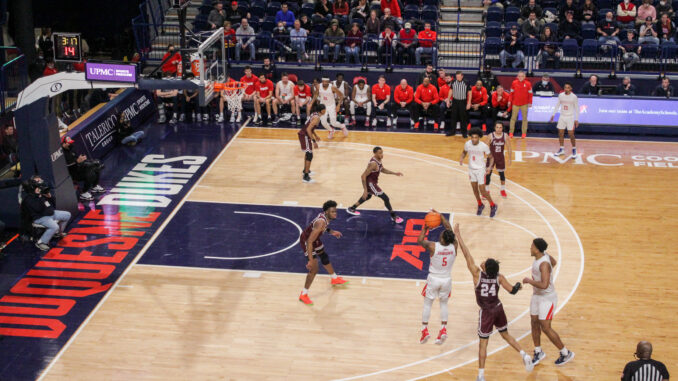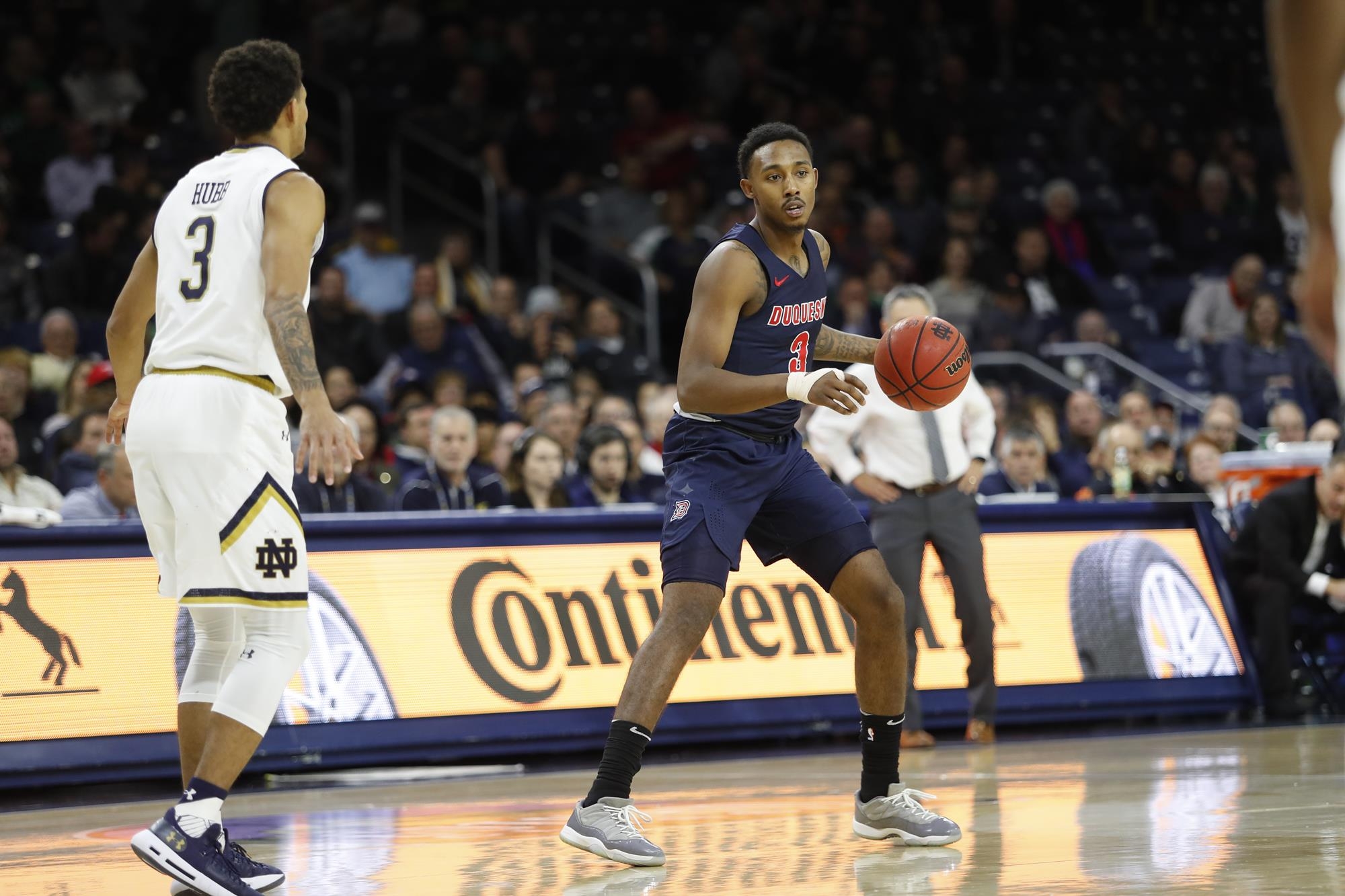
Luke Henne | Sports Editor
March 17, 2022
Just two seasons ago, Pittsburgh’s NCAA Division I college basketball landscape looked as good as it had in a long time.
Robert Morris went 20-14 and swept its way through the Northeast Conference tournament to earn an automatic bid to the NCAA Tournament for the first time since 2014-15. Duquesne went 21-9 and was postseason bound for the first time since 2015-16. Pitt went 16-17, but improved by eight wins from an abysmal 8-24 campaign in 2017-18.
Yet, just 24 months later, all three major teams rounded out painful seasons with no postseason competition in sight, combining for a 25-69 record during the 2021-22 season.
How did this happen?
Finding the talent necessary for high-level success, at least up until 2020-21, was not a problem.
These programs were plundered by the NCAA’s transfer portal. In response, the teams’ head coaches did not add enough talent from the market, at least enough to fill the gaps left by the flurry of players who transferred out of Pittsburgh to other schools.
Once Covid-19 abruptly canceled all postseason competition in March 2020 and drastically impacted the duration of the 2020-21 season (and even a bit of this season), roster shuffling went off the rails.
In response to the uncertain landscape, the NCAA loosened its restrictions for players transferring in and out of programs. Student-athletes no longer had to sit out a year and could immediately make an impact at a new university.
Under Jeff Capel, Pitt started the 2020-21 season with eight wins in its first 10 games and found itself near top of the Atlantic Coast Conference standings. However, the Panthers won just two of their final 12 games, finishing with a losing record (10-12) for the fifth season in a row.
In the same week during that year, two of Pitt’s top scorers decided to depart from the program. Au’Diese Toney (averaged 14.4 points/game in 2020-21, transferred to Arkansas) and Xavier Johnson (averaged 14.2 points/game in 2020-21, transferred to Indiana) both found homes at bigger-name programs that earned a berth into this season’s NCAA Tournament.
Following these departures and the loss of Justin Champagnie (signed with the National Basketball Association’s Toronto Raptors after the 2020-21 season), Capel’s most-promising talent had all gone elsewhere.
Entering 2021-22, Capel would have to rely on Ithiel Horton (transferred from Delaware prior to 2019-20) and Nike Sibande (transferred from Miami (Ohio) prior to 2020-21) to step up and fill the holes left by those who departed.
Before the regular season even began, Sibande tore his ACL in an exhibition game, and Horton was arrested for charges including aggravated assault. Sibande missed the entire season, while Horton was held out for a majority of the campaign.
An already-thin roster then turned its hope toward transfers like Mouhamadou Gueye (transfer from Stony Brook, averaged 9.8 points/game in 2021-22) and Jamarius Burton (transfer from Texas Tech, averaged 12.4 points/game in 2021-22), but it was not enough.
Pitt buried itself with a 3-7 start to the season, including home losses to mid-major programs like The Citadel, UMBC and Monmouth. The Panthers never recovered, going 11-21 and bowing out in ugly fashion to Boston College in the ACC tournament’s opening round on March 8.
Following the 20-point loss, according to Craig Meyer of the Pittsburgh Post-Gazette, Capel said, “We need to get better players. It’s not anything personal. We have to continue to add better players and recruit better players.”
In four years, Capel has lost so much talent, yet he’s done next to nothing to address the losses. And, with a comment like that, losing talent from this year’s team like John Hugley (averaged 14.8 points/game and 7.9 rebounds/game) wouldn’t be all that surprising.
For Keith Dambrot, Duquesne looked to be in strong position in 2020-21, but that was soon tempered. A season highlighted by Covid stoppages saw the Dukes go a modest 9-9, losing Sincere Carry and Lamar Norman Jr. to the transfer wire in the process.
Carry went to Kent State, where he helped guide the Golden Flashes to a 14-game winning streak this season, while also being honored as the Mid-American Conference Player of the Year. Norman Jr. wound up at Western Michigan, also in the MAC, where he averaged a team-high 19.8 points/game in 2021-22.
Others followed suit at the end of the 2020-21 season. Marcus Weathers (averaged 15.3 points/game) teamed up with his brother, Michael, at SMU. Chad Baker-Mazara (averaged 9.5 points/game) left to go to San Diego State and Tavian Dunn-Martin (averaged 10.2 points/game) headed south for Florida Gulf Coast.
Dambrot got contributions from additions like Kevin Easley Jr. (transferred from TCU, averaged 10.7 points/game) and Tre Williams (transferred from Indiana State, averaged 10.8 points/game) in 2021-22, but the young roster lost 17 games in a row to close out the campaign. This season’s Dukes won their fewest games in a season (six) since 2005-06, when they went 3-24.
After a 24-point home loss to Davidson on Feb. 23, Dambrot said, “There’s no question I overcorrected [when building this season’s roster]. I still think I did the right thing by morals’ and ethics’ standards, but I hurt myself, and I hurt our school, and I hurt our team. So, I overcorrected. We had too much [expletive] that went on [with teams in previous seasons] and I had enough … ”
Although the culture might be better now, the winning is not there. Dambrot, who will return next season, is now tasked with finding a balanced mix of talent and coachable players.
The roster shuffling continued on Monday, when Pittsburgh Sports Now reported that Toby Okani (averaged 3.9 points/game in 2021-22) will transfer away from Duquesne.
While Andy Toole’s Robert Morris rosters weren’t torn down like Capel’s and Dambrot’s were, the 2020-21 team saw the graduations of three key seniors from a season before (Josh Williams, Sayveon McEwen and Yannis Mendy). These three players were implicated by the NCAA’s decision to not grant an extra year of eligibility to athletes who competed during 2019-20 winter sports.
An ugly 2020-21 season saw a Robert Morris roster filled with inexperienced players go 4-15, with one of those wins coming against Point Park (a non-NCAA school). In 2021-22, just two seasons removed from a championship run, not a single player remained from the title team.
Toole did bring in players like Ferron Flavors Jr. (Oklahoma State) and Rasheem Dunn (St. John’s) from major programs, but both of them were gone before the season even hit its halfway point.
Players like Kahliel Spear (transferred from Bucknell prior to 2020-21, averaged 14.7 points/game in 2021-22) and Michael Green III (transferred from Bryant prior to 2021-22, averaged 10.4 points/game) helped the Colonials steal a few wins.
However, Robert Morris won just eight games in 2021-22 and suffered an excruciating home loss to IUPUI on Feb. 17. The Jaguars, who dressed only six players in the game and even tweeted out an intention to hold open tryouts just days earlier, earned their only Division I of the season with a road win over the Colonials.
Two more Robert Morris players — Brandon Stone (averaged 6.5 points/game in 2021-22) and Kam Farris (averaged 9.2 points/game in 2021-22) — announced their intentions to depart from the team this week, per Pittsburgh Sports Now.
So, where do things go from here? Can it get any worse?
With the NCAA Tournament — a common goal for most Division I programs — underway this week, it’s clear that Duquesne, Pitt and Robert Morris have a long way to go in getting back to postseason competition.
This season’s results provide enough evidence to suggest that a good situation can turn ugly in a very brief period of time.
While Capel, Toole and Dambrot could change coaching philosophies to appease current players or find new, refreshing ways to pitch to recruits, there seems to be one solid way to address roster shortcomings: take advantage of the NCAA’s transfer portal by any means necessary.
Once these coaches add the talent, they need to find ways to maintain it. If they don’t, as seen recently, the losses will pile up and fans will quickly lose interest (if that hasn’t already happened).




